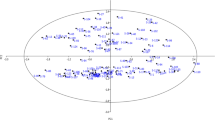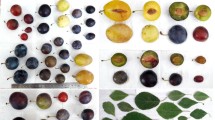Abstract
The purpose of this study was to characterize the Irano-Caucasian apricot germplasm that was collected in Anatolia, Turkey. Fifteen (pomological, phenological, and yield) parameters were studied in this germplasm, consisting of 128 apricot cultivars and types. A wide variation was found in harvest season, fruit yield, total solids soluble (TSS), total acidity, fruit, pit, and kernel mass. Most of the cultivars and types had a relatively small fruit size; only seven had a fruit mass ≥50 g. In general, fruits had yellow skin ground color and flesh color as well as mostly sweet kernels and high TSS. While there was a high correlation between fruit, pit and kernel mass and also between TSS and total acidity, a low or no significant correlation was determined between other pomological or phenological characteristics. The Levent apricot type possessed a substantially late ripening with a total period of 190–200 days for fruit development, a characteristic that makes this apricot type highly suitable for breeding studies.
Similar content being viewed by others
References
Anonoymus 2002. Malatya Agriculture Country Department Registers, Malatya.
N. Arı (1999) Apricot Kernel Oil (Kayısı tohum yagı) Effective Compounds and its Used Ankara Üniversitesi Saglık Bilimleri Enstitusü
B.M. Asma E. Yigit Y. Akca (1994) ArticleTitleA study on the determination tolerance of the important apricot cultivars to low temperatures Yuzuncu Yıl Univ. J. Agric. Fac. 4 87–94
B.M. Asma (2000) Apricot Growing Evin Press MalatyaTurkey
J.M. Audergon M. Souty J.M. Duffı ıllol M. Breulls (1991) ArticleTitleBiochemical and physicochemical characterisation of 400 apricot varieties consequences in the apricot selection and improvement process Acta Horticul. 293 111–119
M.L. Badenes J. Martinez-Calvo G. Llacer (1998) ArticleTitleAnalysis of apricot germplasm from the European ecogeographical group Euphytica 102 93–99 Occurrence Handle10.1023/A:1018332312570
D.H. Byrne A.N. Nikolic E.E. Burns (1991) ArticleTitleVariability in sugars, acids, firmness, and color characteristics of 12 peach genotypes J. Amer. Soc. Sci. 116 1004–1006
B. Cemeroglu (1992) The Basic Analysis Methods in Fruit and Vegetable Processing Industry Arsu Press Ankara
L. Camlı ıbel (1996) Igeme the Profile of Product. Agriculture IGEME Ankara
InstitutionalAuthorNameDIE (1998) Agriculture Statistics Basbakanlı ık Presss Ankara
M. Dokuzoguz (1966) ArticleTitlePomological studies on Aegean region’s apricot cultivars Ege Univ. J. Agric. Fac. 3 IssueID(2) 60–77
FAO, 2002. FAO statistical database, http://apps.fao.org/page/collections?subset=agriculture.
R. Guerriero D. Bassi F. Pennone (1995) ArticleTitleItalian apricot germplasm: overview and outlook Acta Horticul. 384 255–260
R. Gulcan (1988) ArticleTitleApricot cultivars in Near East Acta Horticul. 209 49–54
M. Guleryuz (1988) A study on breeding by selection of wild apricots quality and resistance to spring frosts in erzincan plain Ataturk University Faculty of Agriculture Erzurum
K.W. Hilling A. Iezzoni (1988) ArticleTitleMultivariate analysis in a sour cherry germplasm collection J. Amer. Soc. Sci. 113 928–934
R. Kadı ıoglu (1977) Breeding by selection of wild apricots late flowering and resistance to late spring frosts. Some Researches Completed in Various Agricultural Institutes Ege Agricultural Research Institute Press Izmir 142–150
M. Niklasson S. Bjarnason (1989) The European Apricot Catalogue Nordic Gen Bank: 3, SLU Prees Repro & Alnarp
S. Ozbek (1978) Special Horticulture. Cukurova University Faculty of Agriculture publications number 128 Ankara University Press Ankara
S.A. Paunovic (1988) ArticleTitleApricot cultivars Prunus armeniaca L. in Europe Acta Horticul. 209 83–114
S. Perez-Gonzales (1992) ArticleTitleAssociation among morphological and phenological characters representing apricot germplasm in central Mexico J. Amer. Soc. Sci. 117 IssueID(3) 486–490
S. Perez-Gonzales S. Montens C. Mejia (1993) ArticleTitleAnalysis of peach germplasm in Mexico J. Amer Soc. Sci. 118 IssueID(4) 519–524
L. Ulkumen (1973) Horticulture. Ataturk University Faculty of Agriculture publications number 128 Ataturk University Press Erzurum
M.S. Unal M. Sahin H. Olmez B. Celik B.M. Asma M. Bas (1999) The Breeding of Late Flowering and Resistance to Late Spring Frosts Apricots through Crossing (First Phase) Fruit Research Institute Malatya
Author information
Authors and Affiliations
Corresponding author
Rights and permissions
About this article
Cite this article
Asma, B., Ozturk, K. Analysis of morphological, pomological and yield characteristics of some apricot germplasm in Turkey. Genet Resour Crop Evol 52, 305–313 (2005). https://doi.org/10.1007/s10722-003-1384-5
Received:
Accepted:
Issue Date:
DOI: https://doi.org/10.1007/s10722-003-1384-5




